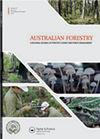Indole acetic-producing bacteria promote the root development of Acacia mearnsii cuttings
IF 1.2
4区 农林科学
Q3 FORESTRY
引用次数: 0
Abstract
ABSTRACTBlack wattle (Acacia mearnsii) is one of the most important commercial tree species in southern Brazil, where it is planted for multiple uses, such as cellulose pulp production and tannin extraction. Recently, forest companies have been directing their efforts towards vegetative propagation to improve the productivity of black-wattle plantations. However, rooting rates of this species are low, even when treated with the synthetic auxin indole-3-butyric acid (IBA). Thus, rooting black-wattle cuttings is still considered a bottleneck for industry development. On the other hand, it is known that inoculating cuttings with indole acetic acid (IAA)-producing bacteria can be an efficient method for increasing vegetative propagation. This study investigated the potential of two bacterial strains to promote root development in black wattle. The strains SEMIA 436 and 439 (Agrobacterium radiobacter), previously isolated from the common bean and detected as high-IAA producers, were also evaluated in relation to their colonisation capacity in seedling roots. Results showed that inoculation with both strains increased rooting rates by 20−30% compared with non-treated and IBA-treated cuttings. Moreover, inoculation increased root dry mass, length and volume. Strain SEMIA 436 demonstrated higher colonisation capacity.KEYWORDS: black wattleSEMIA 436SEMIA 439indole acetic acid AcknowledgmentsThe authors would like to thank the anonymous reviewers for their comments, which helped improve the manuscript.Disclosure statementNo potential conflict of interest was reported by the author(s).吲哚产酸菌促进金合欢插枝根系发育
摘要黑荆(Acacia mearnsii)是巴西南部最重要的商业树种之一,在那里它被种植用于多种用途,如纤维素纸浆生产和单宁提取。最近,森林公司一直致力于无性繁殖,以提高黑荆树种植园的生产力。然而,即使用人工合成的生长素吲哚-3-丁酸(IBA)处理,该物种的生根率也很低。因此,黑荆扦插生根仍被认为是产业发展的瓶颈。另一方面,已知在插枝上接种产生吲哚乙酸(IAA)的细菌是提高无性繁殖的有效方法。研究了两株病原菌促进黑荆树根系发育的潜力。先前从普通豆中分离到的菌株SEMIA 436和439(放射农杆菌)也被检测为高iaa生产者,它们在幼苗根部的定殖能力也被评估。结果表明,与未处理和iba处理的插条相比,接种这两种菌株的插条生根率提高了20 ~ 30%。此外,接种增加了根的干质量、长度和体积。菌株SEMIA 436表现出更高的定植能力。关键词:黑荆芥emia 436SEMIA 439吲哚乙酸作者感谢匿名审稿人的意见,他们的意见对本文的改进起到了很大的帮助。披露声明作者未报告潜在的利益冲突。
本文章由计算机程序翻译,如有差异,请以英文原文为准。
求助全文
约1分钟内获得全文
求助全文
来源期刊

Australian Forestry
FORESTRY-
CiteScore
3.70
自引率
4.80%
发文量
15
审稿时长
>12 weeks
期刊介绍:
Australian Forestry is published by Taylor & Francis for the Institute of Foresters of Australia (IFA) for scientific, technical, and professional communication relating to forestry in the Asia Pacific.
 求助内容:
求助内容: 应助结果提醒方式:
应助结果提醒方式:


